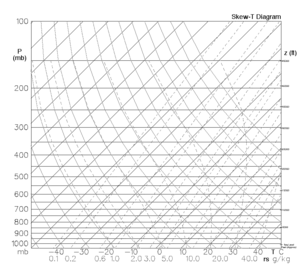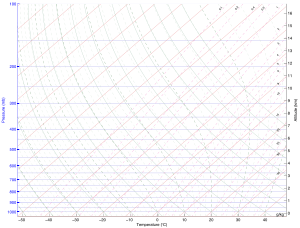Skew-T log-P diagram


A Skew-T Log-P diagram is one of four thermodynamic diagrams commonly used in weather analysis and forecasting. In 1947, N. Herlofson proposed a modification to the emagram which allows straight, horizontal isobars, and provides for a large angle between isotherms and dry adiabats, similar to that in the tephigram. It was thus more suitable for some of the newer analysis techniques being invented by the United States Air Force.
The major use for skew-T log-P diagrams is the plotting of radiosonde soundings, which give a vertical profile of the temperature and dew point through the atmosphere above a certain point on the ground. The isopleths on the diagram can then be used to simplify many tedious calculations involved, which were previously performed by hand or not at all.
See also
Bibliography
- J.V. Iribarne and W.L. Godson, Atmospheric Thermodynamics, 2nd Edition, published by D. Reidel Publishing Company, Dordrecht, the Netherlands, 1981, 278 pages, ISBN 90-277-1297-2, ISBN 978-90-277-1297-4
- G.W. Petty, A First Course in Atmospheric Thermodynamics, Sundog Publishing, 2008, 338 pp. ISBN 978-0-9729033-2-5
- M K Yau and R.R. Rogers, Short Course in Cloud Physics, Third Edition, published by Butterworth-Heinemann, January 1, 1989, 304 pages. EAN 9780750632157 ISBN 0-7506-3215-1
External links
- Downloadable/printable Skew-T log-P diagrams in PDF format
- NOAA observed sounding archive
- Printable blank Skew-T diagrams in multiple densities